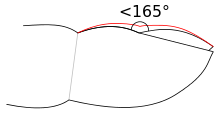What are the causes of finger and toe clubbing?
What is clubbing?
Clubbing of the nails is soft tissue swelling of the terminal phalanx, resulting in the straightening of the angle between the nail bed and the nail. The angle between the nail bed and the nail fold is ≥180 degrees (a normal angle is <165 degrees).



Causes of clubbing
There are 52 (or more) recognised causes of clubbing, which can be divided into the following groups. Commoner causes are in bold. 10 or these 52 are an (under) estimate of the myriad number of causes of pulmonary fibrosis.
- Respiratory
- Lung cancer (80% of cases of clubbing). Clubbing is in general an ominous sign for this, and remember ‘beware the yellow clubbed digit’ (yellow from nicotine, and clubbed from cancer)
Note. Other intrathoracic neoplasia can cause clubbing – e.g. malignant and benign pleural tumours, metastatic cancers, Hodgkin lymphoma, thymoma, pulmonary artery sarcoma, lung lymphosarcoma, nasopharyngeal carcinoma, rhabdomyosarcoma, and oesophageal cancer - Chronic suppurative lung disease – bronchiectasis, cystic fibrosis, lung abscess, TB (with chronic lung infection), empyema, chronic fungal sepsis
- Pulmonary fibrosis (interstitial lung disease) – and its many causes
- Sarcoidosis
- Asbestosis/pleural mesothelioma
- Other lung diseases – Langerhans cell histiocytosis, lipoid pneumonia, and pulmonary arteriovenous malformation
- COPD IS NOT A CAUSE OF CLUBBING (if you seen clubbing in a COPD patient, think lung cancer) – neither is asthma or pneumonia.
- Lung cancer (80% of cases of clubbing). Clubbing is in general an ominous sign for this, and remember ‘beware the yellow clubbed digit’ (yellow from nicotine, and clubbed from cancer)
- Cardiac
- Congenital cyanotic heart disease
- Infective endocarditis
- Eisenmenger’s syndrome (L to R shunt)
- Atrial myxoma
- Tetralogy of Fallot.
- Gastrointestinal
- Inflammatory bowel disease
- Coeliac disease – and other cause of chronic malabsorption
- GI lymphoma
- Primary biliary cirrhosis
- Hepatoma.
- Other
- Thyrotoxicosis (thyroid acropachy)
- Hereditary/idiopathic (pachydermoperiostosis or Touraine-Solente-Gole syndrome)
- Sickle cell disease
- Hemiplegic stroke.
Rare causes
- Ascariasis
- Amoebiasis
- Overuse of certain drugs, including laxatives, interferon alfa-2A and prostaglandin infusion
- Neurogenic diaphragmatic tumours
- Severe secondary hyperparathyroidism
- Pregnancy.
Unilateral clubbing (often vascular)
- Bronchial arteriovenous aneurysm
- Aneurysm – subclavian or axillary artery, brachiocephalic trunk
- Pre-subclavian coarctation of aorta (left-sided clubbing)
- Pancoast tumour
- Unilateral erythromelalgia
- Arteriovenous fistula used for haemodialysis
- Infected arterial graft.
Note 1. Hypertrophic pulmonary osteoarthropathy (HPOA). If a patient has painful wrists, painful ankles and clubbing, they may have HPOA. The causes of HPOA are the same as those of clubbing.
Note 2. Pseudoclubbing. Distinguished from clubbing by the preservation of the nail-fold angle and bony erosion of the terminal phalanges on radiography. Pseudoclubbing is also more likely to be asymmetrical.
Summary
We have described what are the causes of finger and toe clubbing. We hope it has been helpful.
Other resources
Medical diagnostic handshake
Review articles: Sarkar, 2012, Burcovschii, 2022
Last Reviewed on 5 July 2024
